外研版七年级英语上册各单元知识点汇总(全册)
文档属性
| 名称 | 外研版七年级英语上册各单元知识点汇总(全册) |
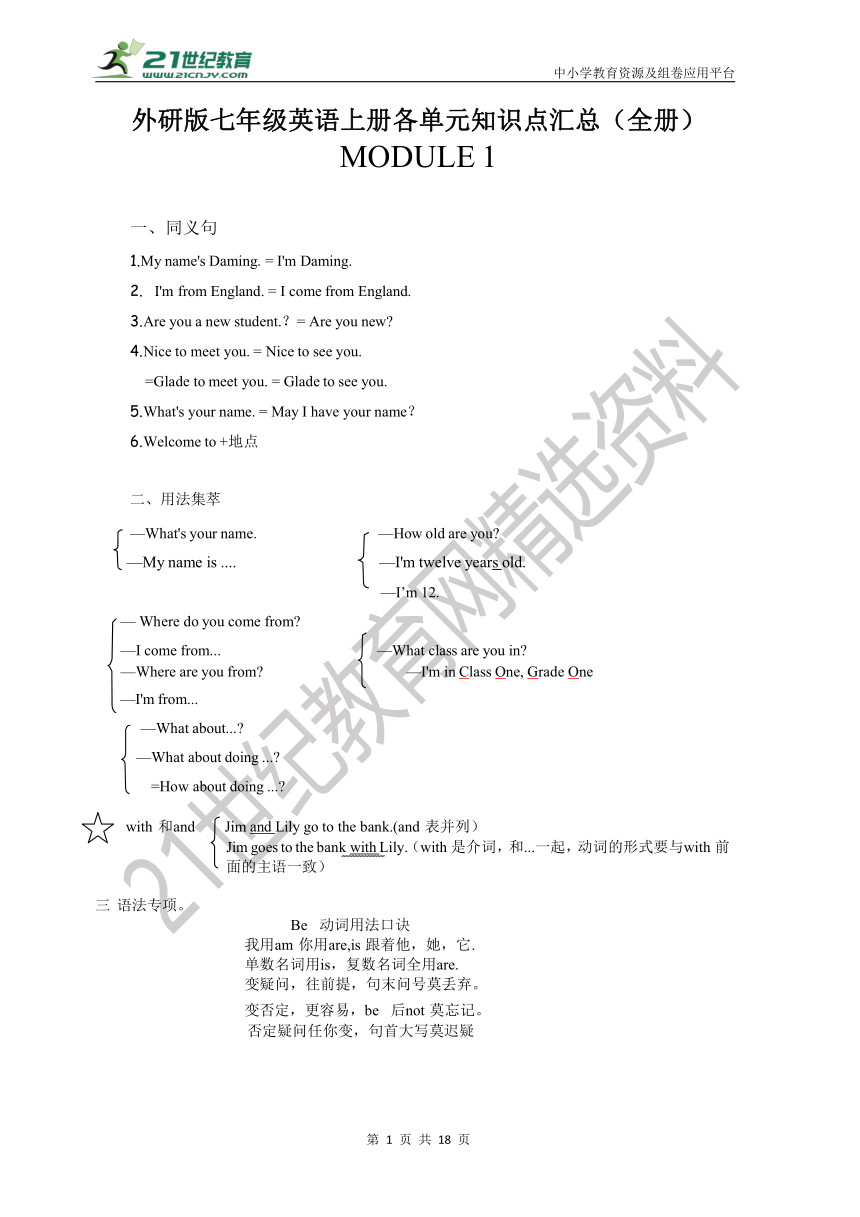
|
|
| 格式 | docx | ||
| 文件大小 | 632.8KB | ||
| 资源类型 | 试卷 | ||
| 版本资源 | 外研版 | ||
| 科目 | 英语 | ||
| 更新时间 | 2022-12-23 10:34:40 | ||
图片预览

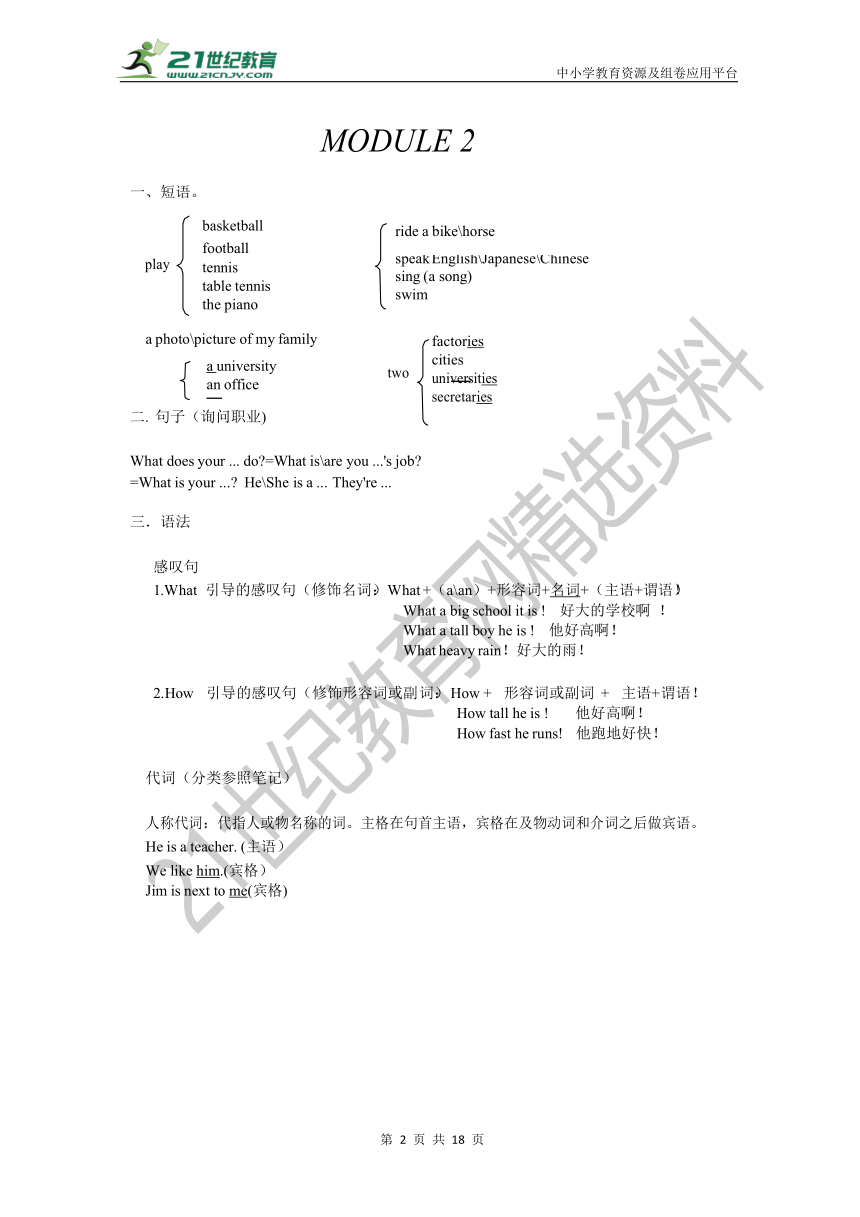
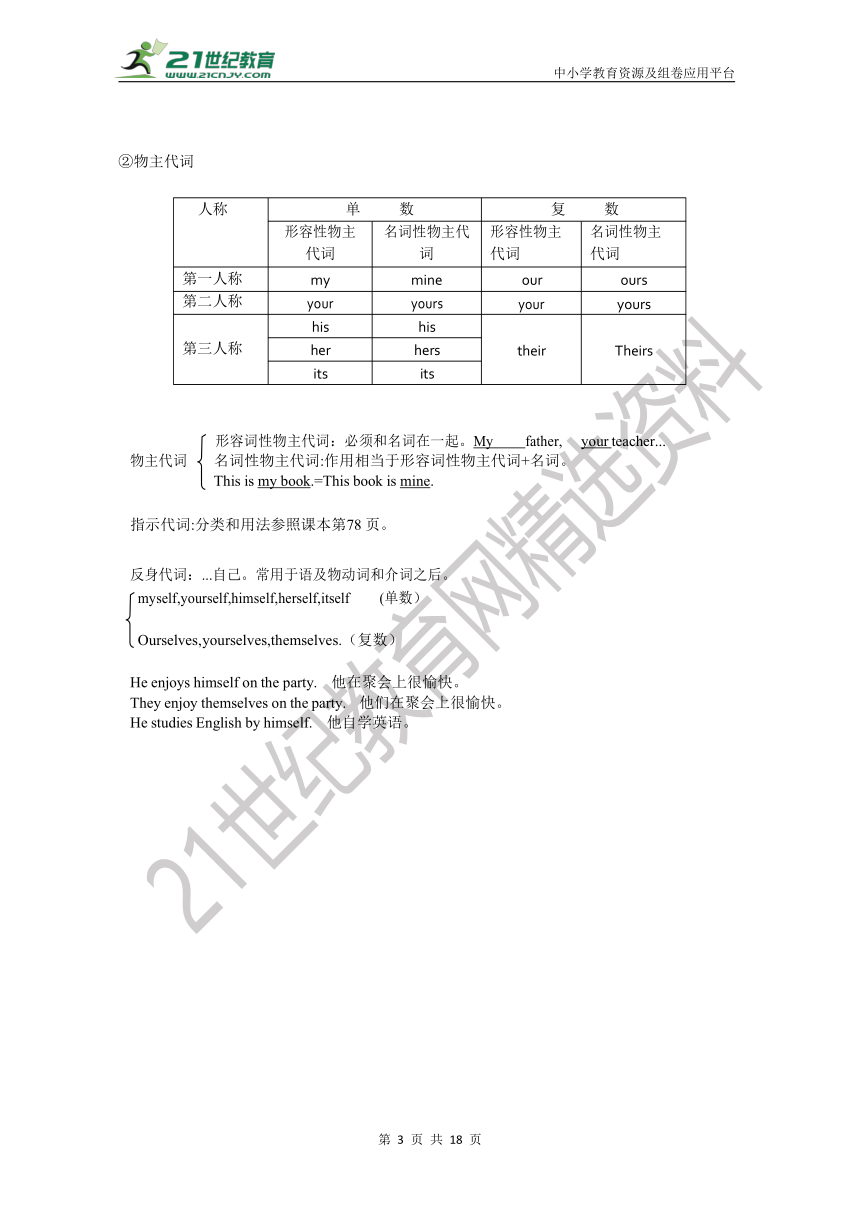
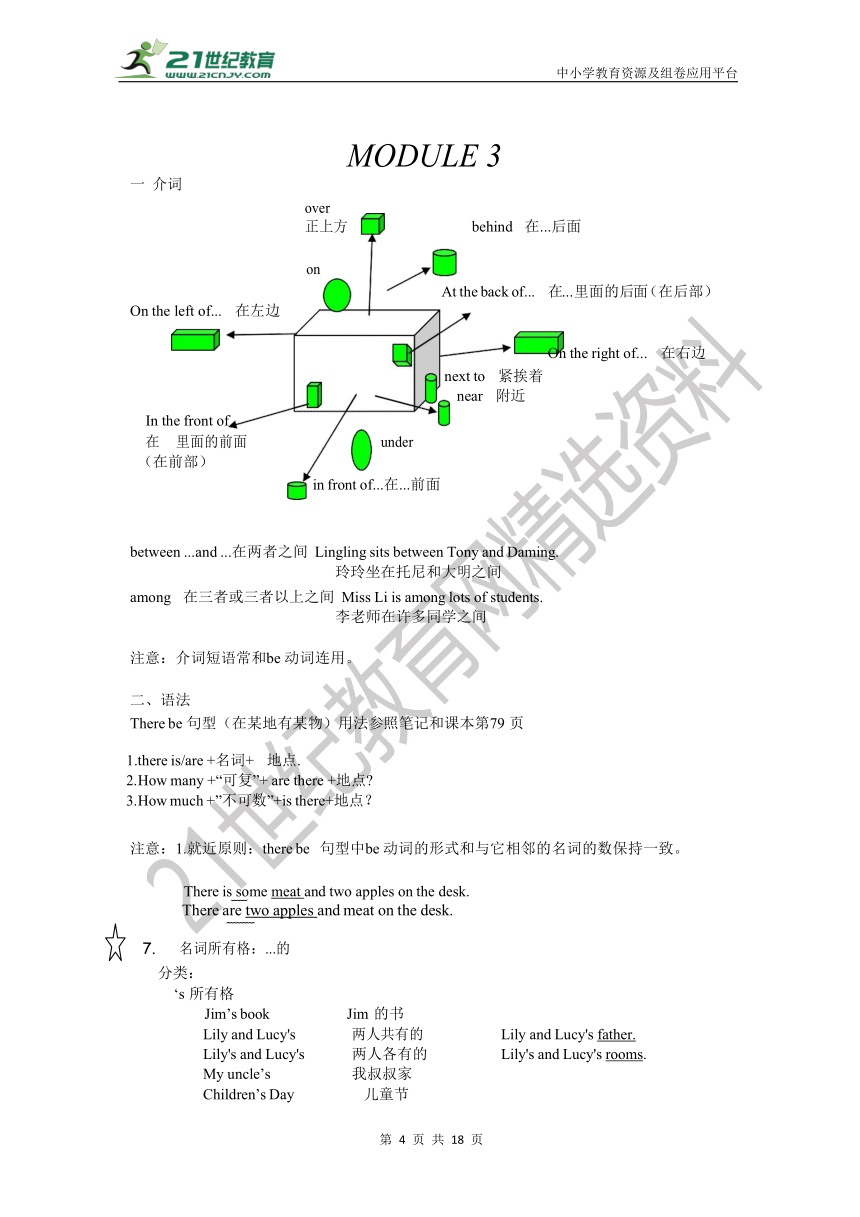
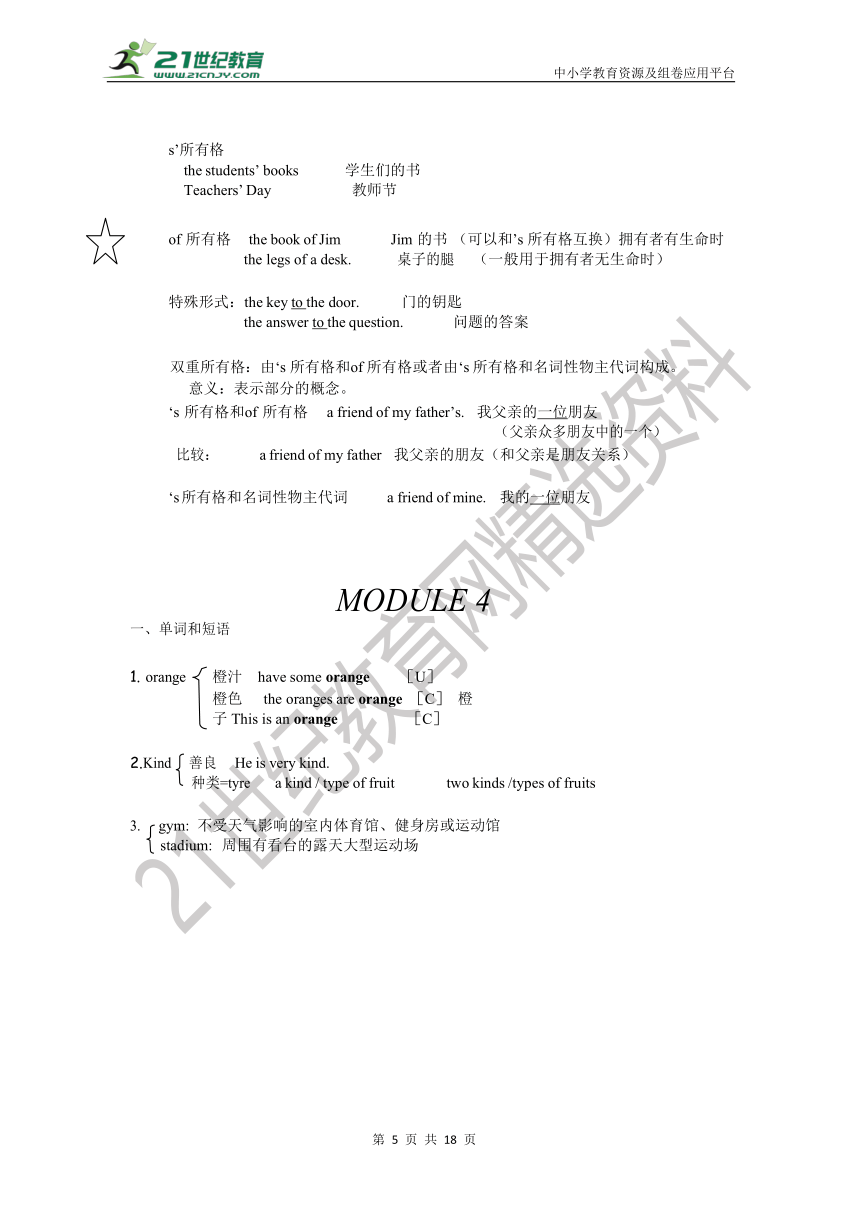
文档简介
外研版七年级英语上册各单元知识点汇总(全册)
MODULE 1
一、同义句
My name's Daming. = I'm Daming.
I'm from England. = I come from England.
Are you a new student.?= Are you new
Nice to meet you. = Nice to see you.
=Glade to meet you. = Glade to see you.
What's your name. = May I have your name?
Welcome to +地点
二、用法集萃
—What's your name. —How old are you
—My name is .... —I'm twelve years old.
中小学教育资源及组卷应用平台
—I’m 12.
— Where do you come from
—I come from... —What class are you in
—Where are you from —I'm in Class One, Grade One
—I'm from...
—What about...
—What about doing ...
=How about doing ...
with 和 and Jim and Lily go to the bank.(and 表并列)
Jim goes to the bank with Lily.(with是介词,和...一起,动词的形式要与 with 前面的主语一致)
三 语法专项。
Be 动词用法口诀
我用 am 你用 are,is 跟着他,她,它.
单数名词用 is,复数名词全用 are.
变疑问,往前提,句末问号莫丢弃。
变否定,更容易,be 后 not 莫忘记。
否定疑问任你变,句首大写莫迟疑
MODULE 2
一、短语。
basketball football
ride a bike\horse
play
tennis
table tennis the piano
speak English\Japanese\Chinese
sing (a song) swim
a photo\picture of my family
a university an office
二. 句子(询问职业)
two
factories cities universities secretaries
What does your ... do =What is\are you ...'s job
=What is your ... He\She is a ... They're ...
三.语法
感叹句
1.What 引导的感叹句(修饰名词):What +(a\an)+形容词+名词+(主语+谓语)!
What a big school it is ! 好大的学校啊 !
What a tall boy he is ! 他好高啊!
What heavy rain!好大的雨!
2.How 引导的感叹句(修饰形容词或副词):How + 形容词或副词 + 主语+谓语!
How tall he is ! 他好高啊!
How fast he runs! 他跑地好快!
代词(分类参照笔记)
人称代词:代指人或物名称的词。主格在句首主语,宾格在及物动词和介词之后做宾语。
He is a teacher. (主语)
We like him.(宾格)
Jim is next to me(宾格)
②物主代词
形容词性物主代词:必须和名词在一起。My father, your teacher...
物主代词 名词性物主代词:作用相当于形容词性物主代词+名词。
This is my book.=This book is mine.
指示代词:分类和用法参照课本第 78 页。
反身代词:...自己。常用于语及物动词和介词之后。
myself,yourself,himself,herself,itself (单数)
Ourselves, yourselves,themselves.(复数)
He enjoys himself on the party. 他在聚会上很愉快。
They enjoy themselves on the party. 他们在聚会上很愉快。
He studies English by himself. 他自学英语。
一 介词
over
MODULE 3
正上方 behind 在...后面
on
On the left of... 在左边
At the back of... 在...里面的后面(在后部)
In the front of
在 里面的前面 under
(在前部)
next to 紧挨着
near 附近
On the right of... 在右边
in front of...在...前面
between ...and ...在两者之间 Lingling sits between Tony and Daming.
玲玲坐在托尼和大明之间
among 在三者或三者以上之间 Miss Li is among lots of students.
李老师在许多同学之间
注意:介词短语常和 be 动词连用。
二、语法
There be 句型(在某地有某物)用法参照笔记和课本第 79 页
1.there is/are +名词+ 地点.
How many +“可复”+ are there +地点
How much +”不可数”+is there+地点?
注意:1.就近原则:there be 句型中 be 动词的形式和与它相邻的名词的数保持一致。
There is some meat and two apples on the desk.
There are two apples and meat on the desk.
名词所有格:...的
分类:
‘s 所有格
Jim’s book Jim 的书
Lily and Lucy's 两人共有的 Lily and Lucy's father. Lily's and Lucy's 两人各有的 Lily's and Lucy's rooms. My uncle’s 我叔叔家
Children’s Day 儿童节
s’所有格
the students’ books 学生们的书
Teachers’ Day 教师节
of 所有格 the book of Jim Jim 的书 (可以和’s 所有格互换)拥有者有生命时
the legs of a desk. 桌子的腿 (一般用于拥有者无生命时)
特殊形式:the key to the door. 门的钥匙
the answer to the question. 问题的答案
双重所有格:由‘s 所有格和 of 所有格或者由‘s 所有格和名词性物主代词构成。
意义:表示部分的概念。
‘s 所有格和 of 所有格 a friend of my father’s. 我父亲的一位朋友
(父亲众多朋友中的一个) 比较: a friend of my father 我父亲的朋友(和父亲是朋友关系)
‘s 所有格和名词性物主代词 a friend of mine. 我的一位朋友
一、单词和短语
MODULE 4
orange 橙汁 have some orange [U]
橙色 the oranges are orange [C] 橙子This is an orange [C]
Kind 善良 He is very kind.
种类=tyre a kind / type of fruit two kinds /types of fruits
3. gym: 不受天气影响的室内体育馆、健身房或运动馆
stadium: 周围有看台的露天大型运动场
keep/stay healthy be in poor/bad health in good health be unhealthy be bad for one’s health
be healthy be in health
be good for one’s health
指数量(不可数)There is much drink in the fridge.
food, fruit ,drink 冰箱里有许多饮料。
指种类(可数) Water and milk are healthy drinks.
牛奶和水是健康的饮品。
or 的用法: ① 或: I drink water or cola. 我喝牛奶或水
② 并列 (否定句): I don't like swimming or dancing.
我不喜欢游泳和舞蹈。
二 语法 名词
一般规则:
特殊变化:
元音字母交替 man-men woman-women foot-feet tooth-teeth mouse-mice
单复数同型 fish deer(鹿)sheep Chinese Japanese
词尾变化 child-children
不可数名词 :(参照笔记不可数名词口诀)
a cup of tea
a glass of water a can of coke
a bottle of juice a bowl of rice
a piece of meat
two cups of tea
two glasses of water two cans of coke two bottles of juice two bowls of rice two pieces of meat
have got 的用法 (参照笔记和课本 80 页)
have got 人拥有... He has got a brother.
比较 have
人有...He has a brother.
物有... The dog has two big eyes.
some 和 any 的用法 参照笔记和课本第 81 页)
some 和 any 的其他用法
Some 用于表建议的疑问句 How about some orange juice
Would you like some ...
any 用于肯定句表示任何一个... Any one should learn English well.
任何人都应该学好英语
一 单词和短语
MODULE 5
breakfast,lunch,dinner,supper home 回家
a break,a rest to school 上学
have English,Chinese go to bed 上床睡觉
a maths lesson to sleep 入睡
a drink
on the weekend在周末
at weekends
weekdays 工作日
On Sunday在周日
Monday morning/afternoon/evening在周一上午/下午/晚上
half past nine the morning
at noon/midday in the afternoon
night the evening
to...和...说话 (一方说一方听)
talk with...和...交谈(双方交谈)
about...和...谈论论关于
二 语法
时间表达法(参照笔记)
What time is it
几点钟 What’s the time
When do you get up What time do you get up
When is your birthday / the film (问日、月、年或某事何时发生)
一般现在时(I )(参照笔记和课本第 82 页)
意义:人或物在日常生活中经常做的事情或经常处于某一状态。 一般现在时的功能:
.表示事物或人物的特征、状态。eg:The sky is blue.
.表示经常性或习惯性的动作。 eg:I get up at six every day.
3.表示客观现实。 eg:The earth goes around the sun.
一般现在时的构成
1. be 动词:主语+be(am,is,are)+其它。eg:I am a boy.
2.行为动词:主语+行为动词(+其它)。 eg:We study English.
结构一:
I
We
You +动词原形.(肯定句)
They have lunch.
The boys (名词复数)
I
We
You +don’t + 动词原形.(否定句)
They don’t have lunch.
The boys (名词复数)
I
we .
Do + You +动词原形 ?(一般疑问句)
the boys (名词复数) have lunch
Yes,主语+do
回答 No,主语+don’t. they
一 单词和短语
① Names of the animals
MODULE 6
camel elephant giraffe kangaroo monkey--monkeys Snake panda lion zebra polar bear wolf--wolves
② 大洲及动物居住地
in Asia Africa Europe Oceania America North/South America the desert / forest / grassland / jungle / sea / wild
my grandparents
Visit the zoo 五千 5 thousand
thousands of students
everyone / everybody + 动词单三形式
be from... = come from ... 15 kilos of bamboo
go and do sth. = go to do sth. 去做某事
go and see the panda . = go to see the panda. 去看熊猫
Here is a/an ...
这有... Here are ..
全世界
all over the world around the world
语法
a little (用于不可数名词) little
一些 (用于肯定句) 几乎没有(在肯定句中构成否定句)
a few ( 用于可数名词复数) few
There is a little milk in the glass.
杯里有一些牛奶
There is little milk in the glass.
杯里几乎没有牛奶
There are a few apples in the fridge.
冰箱里有一些苹果
There few apples in the fridge.
冰箱里几乎没有苹果
一般现在时(Ⅱ)(参照笔记和课本第 83 页)
一般现在时中第三人称行为动词的变化规律
结构二
He
She + 动词第三人称单数.(肯定句) It has two big eyes.
Tony
(名词第三人称单数)
He
She + doesn’t + 动词原形.(否定句) It doesn’t have two big eyes.
Tony
(名词第三人称单数)
he she
Does + it + 动词原形 (一般疑问句) Tony have two big eyes
(名词第三人称单数)
一 单词和短语
MODULE 7
connect ... to ... 把连接到
write a name for it 为它命名
on the computer/phone/television 通过电脑、电话、电视
save the document 保存文件
save one's life 拯救生命
do one's homework 做作业
go online/on the Internet 上网
send email and photos 发送邮件和照片
make travel plans 做旅行计划
check the train timetable 查询列车时刻表
get information(a piece of information) 获得信息 (一条信息)
download music 下载音乐 visit one website 访问网站 on the Internet 在网上
weekends 在周末
the weekend
at/on weekdays 在工作日
weekday
switch on/off ... 开启电器 turn on/off ... 关闭电器 mouse mice 老鼠
mouses 鼠标
say +内容 Say goodbye! 说再见!
Speak 语言 Speak English.说英语
to sb. Speak to mum.和妈妈说话
sb. Sth 告诉某人某事
sth to sb. 把某事告诉某人
tell sb. (not) to do sth. 告诉某人(不)做某事
a story Sometimes 有时
some times 几次、几倍
Sometime 某一时间
Some time 一段时间(表将来)
learn to do sth. 学习做某事
plan to do sth . 计划做某事
二 语法
一般现在时(Ⅲ)(参考笔记和课本第 84 页)
结构三: 特殊疑问句
特殊疑问词+ 一般疑问句 ?
特殊疑问词总结:
What 什么(职业,姓名等) when 什么时候 (
where 什么地方 who 谁
Which 哪一个 why 为什么 How 怎么样
what day 星期几 What size 多大尺码
how many 多少(提问可数名词数量)
多少(提问不可数名词数量)
How much
多少钱(提问价格)
How old 几岁(提问年龄)
多长(提问长度)
How long
多长时间(时间持续多久)How long do you go to school
你去学校要多长时间?
How often 多久(提问频率既单位时间发生多少次)
How soon (还要多久时间才能开始或结束)
How soon will he come back 他多久才能回来?
How far (提问距离有多远)
How heavy (提问有多重)
MODULE 8
一 单词和短语
be on 上映...节目
film star 电影明星 football matches 足 球比赛
stay at home 呆在家
the party 在晚会上
at the stadium 体育馆 Cinema 在电影院 night 在晚上
the photo 在照片里
in the fridge 在冰箱里
China / Beijing
2008 中国、北京、2008
see a film / see films = go to the cinema
watch a movie /movies看电影 二 句型
It’s + 形容词 + to do sth.做某事是...
on sth.
人+spend(s)+时间/金钱 某人在...花钱/时间
in doing sth.
某人在做某事上花钱/时间
Would you like sth?你想要...
to do sth?你愿意做...
Let's do sth. 让我们做...
What's the price of...... ...价格是多少
Best wishes to sb.给...最美好的祝愿
for teachers' day
like practice
Thank you for
Finish +doing sth start
My hobby is...
favourite sport is...
do sth.
我没有时间 watch sb 看到某人做了...
doing sth
看到某人正在做...
四、区别
want would like
ask/invite sb. Tell sb
to do sth.
主语 +
please let would could can must do
does
do sth.
be different from 和...不同
ask sb. (not) to do sth. 让某人(不)做某事
have a habit of ding sth.有做...事的习惯 get sth. from sb. 从某人那里得到...
a box of candies/chocolates 一盒糖、巧克力糖
wear silk shirts 穿着丝绸 T-恤
a pair of jeans/trainers/glasses/shoes
send/give sth. to sb. make/buy/choose sth. for sb.
=send/give sb. sth. =make/buy/choose sb. sth.
(当物为代词时,只能 用 to 或 for 的句型)
lots of a lot of
many +【C】
+【C】或【U】肯定句 肯定或否定句
much +【U】
二 语法 一般现在时(Ⅳ) 频度副词用法
always 总是 usually 通常 often 经常 sometimes 有时 seldom 很少
never 从不 (在肯定句中构成否定句即表否定含义)
1.be 动词之后 Jim is late for school. 2.主语之后行为动词之前 He always goes to school by bike. 3.句首 Sometimes,I go to school by bike.
4.助动词和情态动词之后 I don’t always go to school by bike.
注意 : 在一般现在时中频度副词对行为动词的形式无影响。例如 2,4 .
一 单词和短语
MODULE 9
lie in the sun 躺在阳光下 sth to sb. stand in line 站成一排 send 把...发送给某人 take photos of 给...拍照 sb sth.
wait for...等待... 发送给某人...
the Great Wall 长城 a lot= very much 非常
be on a school trip 进行学校旅行 go back to 回到...
right now 立刻 get on/off 上/下(bus/train...)
be on sale 出售(打折) run for... 追赶...
go to the opera 去歌剧院(听歌剧) enjoy the sun 享受阳光
have a drink 喝饮料
二 句型
enjoy doing sth 喜欢做某事
What about It’s time to do sth.到做某事的时间了 How about doing sth sth
做...怎么样 Thank you /Thanks for 因为...感谢你
doing sth.
Would like to do sth. 愿意做某事 因为做...感谢你
三 语法
现在进行时: 人或物现在或现阶段正在做的事情。
(具体内容参照课本第 85 页)
结构:
肯定句: 主语 +be +现在分词(动词 ing). We are having a school trip now.
否定句: 主语 + be not + 现在分词 (动词 ing). We are not having a school trip now.
一般疑问句:Be + 主语 + 现在分词(动词 ing) ?
Are you having a school trip now
特殊疑问句:特殊疑问词 + 一般疑问句 ?
What are you doing now
注意:
1.如:come,go,leave,start,begin,finish,move 等动词的现在进行时表示动作将要发生而不是表 示动作正在进行。
例如:I am leaving for Beijing. 我将要动身前往北京。
2.常用语现在进行时的时间和单词。
now ,at the /this moment ,look!Listen! 等。
一单词和短语
MODULE 10
at Spring Festival 在春节 Father Christmas 圣诞老人
at Christmas Day 在圣诞节 cook the meal 做饭
make lanterns 扎灯笼 be at work=be working 在工作
learn the dragon dance 学舞龙 hurry up 赶快
sweep the floor 扫地 good/bad luck 好运/晦气(坏运气)
get ready for...=be ready for... 为...做准备 have a look 看一看
Put away... 把...收起来,放好 the lion dance 舞狮
sweep away... 扫除 traditional family dinner 传统的家庭大餐
on the same day 在同一天
on Christmas Eve 在圣诞节前夕
二 句型
with sth with sth.
help sb 帮助某人...事 be busy 忙于...事
do sth. in doing sth.
帮助某人做某事 忙于做某事
sb sth.
Give 给某人... sth to sb. 把...给某人
三 语法
一般现在时和现在进行时的比较: 一、概念不同:
一般现在时说明人或物经常性和习惯性做的事情或存在的状态,也表示说话者的能力及自
然现象。而现在进行时表示说话时(瞬间)正在做的事情,也表示目前或现阶段一直在做的 事情。如:
She often does her homework in the evening. 她经常在晚上做作业。 She is doing her homework now. 现在她正在做作业。
二、在构成方式上的不同:
一般现在时中谓语动词的构成有以下三种情况:
①be 动词的一般现在时形式:am,is,are.
②动词 have 的一般现在时形式:have,has.
③其他行为动词的一般现在时形式有动词原形或第三人称单数形式。
而现在进行时中谓语动词的构成是:am/is/are+动词的-ing 形式(现在分词)。
三、时间状语不同:
一般现在时的时间状语主要有:always,usually,often,sometimes,never,every day,
on Sundays,in the morning/afternoon/evening 等;
现在进行时的时间状语主要有:now,these days,this week,at the moment 等,有 时句首有“Look!”、“Listen!”或“It’s+时刻”等词、句存在。如:
We play football in the afternoon.我们在下午踢足球。(一般现在时)
My mother is reading a newspaper now. 我妈妈正在看报纸。(现在进行时)
四、感彩不同:
一般现在时往往不带任何感彩,语气比较肯定。现在进行时常带有一定的感彩,
并多与 always, often 等副词连用。如:
Mr. Li works hard in the factory. 李先生在工厂工作努力。(说明事实,语气比较肯定)
Mr. Li is always working hard in the factory.李先生在工厂工作一直很努力。(表示赞 扬)
五、用语范围不同:
某种表示情感、意识(如 want,like,know 等);表示“有”的 have 等动词,一般不用于 现在进行时,但可用于一般现在时。如:
我现在就想回家。
误:I am wanting to go home now. 正:I want to go home now.
他有一台电脑。
误:He is having a computer.
正:He has a computer.
六、时间范围不同:
这两种时态所表示的时间范围都可能有“过去——现在——将来”的意味,但相对而言,一 般现在时持续的时间较长,甚至无限。而现在进行时持续的时间较短,可能片刻完成。如:
She comes from Shanghai. 她是上海人。
She is coming from Shanghai.她正从(或即将从)上海来。
MODULE 1
一、同义句
My name's Daming. = I'm Daming.
I'm from England. = I come from England.
Are you a new student.?= Are you new
Nice to meet you. = Nice to see you.
=Glade to meet you. = Glade to see you.
What's your name. = May I have your name?
Welcome to +地点
二、用法集萃
—What's your name. —How old are you
—My name is .... —I'm twelve years old.
中小学教育资源及组卷应用平台
—I’m 12.
— Where do you come from
—I come from... —What class are you in
—Where are you from —I'm in Class One, Grade One
—I'm from...
—What about...
—What about doing ...
=How about doing ...
with 和 and Jim and Lily go to the bank.(and 表并列)
Jim goes to the bank with Lily.(with是介词,和...一起,动词的形式要与 with 前面的主语一致)
三 语法专项。
Be 动词用法口诀
我用 am 你用 are,is 跟着他,她,它.
单数名词用 is,复数名词全用 are.
变疑问,往前提,句末问号莫丢弃。
变否定,更容易,be 后 not 莫忘记。
否定疑问任你变,句首大写莫迟疑
MODULE 2
一、短语。
basketball football
ride a bike\horse
play
tennis
table tennis the piano
speak English\Japanese\Chinese
sing (a song) swim
a photo\picture of my family
a university an office
二. 句子(询问职业)
two
factories cities universities secretaries
What does your ... do =What is\are you ...'s job
=What is your ... He\She is a ... They're ...
三.语法
感叹句
1.What 引导的感叹句(修饰名词):What +(a\an)+形容词+名词+(主语+谓语)!
What a big school it is ! 好大的学校啊 !
What a tall boy he is ! 他好高啊!
What heavy rain!好大的雨!
2.How 引导的感叹句(修饰形容词或副词):How + 形容词或副词 + 主语+谓语!
How tall he is ! 他好高啊!
How fast he runs! 他跑地好快!
代词(分类参照笔记)
人称代词:代指人或物名称的词。主格在句首主语,宾格在及物动词和介词之后做宾语。
He is a teacher. (主语)
We like him.(宾格)
Jim is next to me(宾格)
②物主代词
形容词性物主代词:必须和名词在一起。My father, your teacher...
物主代词 名词性物主代词:作用相当于形容词性物主代词+名词。
This is my book.=This book is mine.
指示代词:分类和用法参照课本第 78 页。
反身代词:...自己。常用于语及物动词和介词之后。
myself,yourself,himself,herself,itself (单数)
Ourselves, yourselves,themselves.(复数)
He enjoys himself on the party. 他在聚会上很愉快。
They enjoy themselves on the party. 他们在聚会上很愉快。
He studies English by himself. 他自学英语。
一 介词
over
MODULE 3
正上方 behind 在...后面
on
On the left of... 在左边
At the back of... 在...里面的后面(在后部)
In the front of
在 里面的前面 under
(在前部)
next to 紧挨着
near 附近
On the right of... 在右边
in front of...在...前面
between ...and ...在两者之间 Lingling sits between Tony and Daming.
玲玲坐在托尼和大明之间
among 在三者或三者以上之间 Miss Li is among lots of students.
李老师在许多同学之间
注意:介词短语常和 be 动词连用。
二、语法
There be 句型(在某地有某物)用法参照笔记和课本第 79 页
1.there is/are +名词+ 地点.
How many +“可复”+ are there +地点
How much +”不可数”+is there+地点?
注意:1.就近原则:there be 句型中 be 动词的形式和与它相邻的名词的数保持一致。
There is some meat and two apples on the desk.
There are two apples and meat on the desk.
名词所有格:...的
分类:
‘s 所有格
Jim’s book Jim 的书
Lily and Lucy's 两人共有的 Lily and Lucy's father. Lily's and Lucy's 两人各有的 Lily's and Lucy's rooms. My uncle’s 我叔叔家
Children’s Day 儿童节
s’所有格
the students’ books 学生们的书
Teachers’ Day 教师节
of 所有格 the book of Jim Jim 的书 (可以和’s 所有格互换)拥有者有生命时
the legs of a desk. 桌子的腿 (一般用于拥有者无生命时)
特殊形式:the key to the door. 门的钥匙
the answer to the question. 问题的答案
双重所有格:由‘s 所有格和 of 所有格或者由‘s 所有格和名词性物主代词构成。
意义:表示部分的概念。
‘s 所有格和 of 所有格 a friend of my father’s. 我父亲的一位朋友
(父亲众多朋友中的一个) 比较: a friend of my father 我父亲的朋友(和父亲是朋友关系)
‘s 所有格和名词性物主代词 a friend of mine. 我的一位朋友
一、单词和短语
MODULE 4
orange 橙汁 have some orange [U]
橙色 the oranges are orange [C] 橙子This is an orange [C]
Kind 善良 He is very kind.
种类=tyre a kind / type of fruit two kinds /types of fruits
3. gym: 不受天气影响的室内体育馆、健身房或运动馆
stadium: 周围有看台的露天大型运动场
keep/stay healthy be in poor/bad health in good health be unhealthy be bad for one’s health
be healthy be in health
be good for one’s health
指数量(不可数)There is much drink in the fridge.
food, fruit ,drink 冰箱里有许多饮料。
指种类(可数) Water and milk are healthy drinks.
牛奶和水是健康的饮品。
or 的用法: ① 或: I drink water or cola. 我喝牛奶或水
② 并列 (否定句): I don't like swimming or dancing.
我不喜欢游泳和舞蹈。
二 语法 名词
一般规则:
特殊变化:
元音字母交替 man-men woman-women foot-feet tooth-teeth mouse-mice
单复数同型 fish deer(鹿)sheep Chinese Japanese
词尾变化 child-children
不可数名词 :(参照笔记不可数名词口诀)
a cup of tea
a glass of water a can of coke
a bottle of juice a bowl of rice
a piece of meat
two cups of tea
two glasses of water two cans of coke two bottles of juice two bowls of rice two pieces of meat
have got 的用法 (参照笔记和课本 80 页)
have got 人拥有... He has got a brother.
比较 have
人有...He has a brother.
物有... The dog has two big eyes.
some 和 any 的用法 参照笔记和课本第 81 页)
some 和 any 的其他用法
Some 用于表建议的疑问句 How about some orange juice
Would you like some ...
any 用于肯定句表示任何一个... Any one should learn English well.
任何人都应该学好英语
一 单词和短语
MODULE 5
breakfast,lunch,dinner,supper home 回家
a break,a rest to school 上学
have English,Chinese go to bed 上床睡觉
a maths lesson to sleep 入睡
a drink
on the weekend在周末
at weekends
weekdays 工作日
On Sunday在周日
Monday morning/afternoon/evening在周一上午/下午/晚上
half past nine the morning
at noon/midday in the afternoon
night the evening
to...和...说话 (一方说一方听)
talk with...和...交谈(双方交谈)
about...和...谈论论关于
二 语法
时间表达法(参照笔记)
What time is it
几点钟 What’s the time
When do you get up What time do you get up
When is your birthday / the film (问日、月、年或某事何时发生)
一般现在时(I )(参照笔记和课本第 82 页)
意义:人或物在日常生活中经常做的事情或经常处于某一状态。 一般现在时的功能:
.表示事物或人物的特征、状态。eg:The sky is blue.
.表示经常性或习惯性的动作。 eg:I get up at six every day.
3.表示客观现实。 eg:The earth goes around the sun.
一般现在时的构成
1. be 动词:主语+be(am,is,are)+其它。eg:I am a boy.
2.行为动词:主语+行为动词(+其它)。 eg:We study English.
结构一:
I
We
You +动词原形.(肯定句)
They have lunch.
The boys (名词复数)
I
We
You +don’t + 动词原形.(否定句)
They don’t have lunch.
The boys (名词复数)
I
we .
Do + You +动词原形 ?(一般疑问句)
the boys (名词复数) have lunch
Yes,主语+do
回答 No,主语+don’t. they
一 单词和短语
① Names of the animals
MODULE 6
camel elephant giraffe kangaroo monkey--monkeys Snake panda lion zebra polar bear wolf--wolves
② 大洲及动物居住地
in Asia Africa Europe Oceania America North/South America the desert / forest / grassland / jungle / sea / wild
my grandparents
Visit the zoo 五千 5 thousand
thousands of students
everyone / everybody + 动词单三形式
be from... = come from ... 15 kilos of bamboo
go and do sth. = go to do sth. 去做某事
go and see the panda . = go to see the panda. 去看熊猫
Here is a/an ...
这有... Here are ..
全世界
all over the world around the world
语法
a little (用于不可数名词) little
一些 (用于肯定句) 几乎没有(在肯定句中构成否定句)
a few ( 用于可数名词复数) few
There is a little milk in the glass.
杯里有一些牛奶
There is little milk in the glass.
杯里几乎没有牛奶
There are a few apples in the fridge.
冰箱里有一些苹果
There few apples in the fridge.
冰箱里几乎没有苹果
一般现在时(Ⅱ)(参照笔记和课本第 83 页)
一般现在时中第三人称行为动词的变化规律
结构二
He
She + 动词第三人称单数.(肯定句) It has two big eyes.
Tony
(名词第三人称单数)
He
She + doesn’t + 动词原形.(否定句) It doesn’t have two big eyes.
Tony
(名词第三人称单数)
he she
Does + it + 动词原形 (一般疑问句) Tony have two big eyes
(名词第三人称单数)
一 单词和短语
MODULE 7
connect ... to ... 把连接到
write a name for it 为它命名
on the computer/phone/television 通过电脑、电话、电视
save the document 保存文件
save one's life 拯救生命
do one's homework 做作业
go online/on the Internet 上网
send email and photos 发送邮件和照片
make travel plans 做旅行计划
check the train timetable 查询列车时刻表
get information(a piece of information) 获得信息 (一条信息)
download music 下载音乐 visit one website 访问网站 on the Internet 在网上
weekends 在周末
the weekend
at/on weekdays 在工作日
weekday
switch on/off ... 开启电器 turn on/off ... 关闭电器 mouse mice 老鼠
mouses 鼠标
say +内容 Say goodbye! 说再见!
Speak 语言 Speak English.说英语
to sb. Speak to mum.和妈妈说话
sb. Sth 告诉某人某事
sth to sb. 把某事告诉某人
tell sb. (not) to do sth. 告诉某人(不)做某事
a story Sometimes 有时
some times 几次、几倍
Sometime 某一时间
Some time 一段时间(表将来)
learn to do sth. 学习做某事
plan to do sth . 计划做某事
二 语法
一般现在时(Ⅲ)(参考笔记和课本第 84 页)
结构三: 特殊疑问句
特殊疑问词+ 一般疑问句 ?
特殊疑问词总结:
What 什么(职业,姓名等) when 什么时候 (
where 什么地方 who 谁
Which 哪一个 why 为什么 How 怎么样
what day 星期几 What size 多大尺码
how many 多少(提问可数名词数量)
多少(提问不可数名词数量)
How much
多少钱(提问价格)
How old 几岁(提问年龄)
多长(提问长度)
How long
多长时间(时间持续多久)How long do you go to school
你去学校要多长时间?
How often 多久(提问频率既单位时间发生多少次)
How soon (还要多久时间才能开始或结束)
How soon will he come back 他多久才能回来?
How far (提问距离有多远)
How heavy (提问有多重)
MODULE 8
一 单词和短语
be on 上映...节目
film star 电影明星 football matches 足 球比赛
stay at home 呆在家
the party 在晚会上
at the stadium 体育馆 Cinema 在电影院 night 在晚上
the photo 在照片里
in the fridge 在冰箱里
China / Beijing
2008 中国、北京、2008
see a film / see films = go to the cinema
watch a movie /movies看电影 二 句型
It’s + 形容词 + to do sth.做某事是...
on sth.
人+spend(s)+时间/金钱 某人在...花钱/时间
in doing sth.
某人在做某事上花钱/时间
Would you like sth?你想要...
to do sth?你愿意做...
Let's do sth. 让我们做...
What's the price of...... ...价格是多少
Best wishes to sb.给...最美好的祝愿
for teachers' day
like practice
Thank you for
Finish +doing sth start
My hobby is...
favourite sport is...
do sth.
我没有时间 watch sb 看到某人做了...
doing sth
看到某人正在做...
四、区别
want would like
ask/invite sb. Tell sb
to do sth.
主语 +
please let would could can must do
does
do sth.
be different from 和...不同
ask sb. (not) to do sth. 让某人(不)做某事
have a habit of ding sth.有做...事的习惯 get sth. from sb. 从某人那里得到...
a box of candies/chocolates 一盒糖、巧克力糖
wear silk shirts 穿着丝绸 T-恤
a pair of jeans/trainers/glasses/shoes
send/give sth. to sb. make/buy/choose sth. for sb.
=send/give sb. sth. =make/buy/choose sb. sth.
(当物为代词时,只能 用 to 或 for 的句型)
lots of a lot of
many +【C】
+【C】或【U】肯定句 肯定或否定句
much +【U】
二 语法 一般现在时(Ⅳ) 频度副词用法
always 总是 usually 通常 often 经常 sometimes 有时 seldom 很少
never 从不 (在肯定句中构成否定句即表否定含义)
1.be 动词之后 Jim is late for school. 2.主语之后行为动词之前 He always goes to school by bike. 3.句首 Sometimes,I go to school by bike.
4.助动词和情态动词之后 I don’t always go to school by bike.
注意 : 在一般现在时中频度副词对行为动词的形式无影响。例如 2,4 .
一 单词和短语
MODULE 9
lie in the sun 躺在阳光下 sth to sb. stand in line 站成一排 send 把...发送给某人 take photos of 给...拍照 sb sth.
wait for...等待... 发送给某人...
the Great Wall 长城 a lot= very much 非常
be on a school trip 进行学校旅行 go back to 回到...
right now 立刻 get on/off 上/下(bus/train...)
be on sale 出售(打折) run for... 追赶...
go to the opera 去歌剧院(听歌剧) enjoy the sun 享受阳光
have a drink 喝饮料
二 句型
enjoy doing sth 喜欢做某事
What about It’s time to do sth.到做某事的时间了 How about doing sth sth
做...怎么样 Thank you /Thanks for 因为...感谢你
doing sth.
Would like to do sth. 愿意做某事 因为做...感谢你
三 语法
现在进行时: 人或物现在或现阶段正在做的事情。
(具体内容参照课本第 85 页)
结构:
肯定句: 主语 +be +现在分词(动词 ing). We are having a school trip now.
否定句: 主语 + be not + 现在分词 (动词 ing). We are not having a school trip now.
一般疑问句:Be + 主语 + 现在分词(动词 ing) ?
Are you having a school trip now
特殊疑问句:特殊疑问词 + 一般疑问句 ?
What are you doing now
注意:
1.如:come,go,leave,start,begin,finish,move 等动词的现在进行时表示动作将要发生而不是表 示动作正在进行。
例如:I am leaving for Beijing. 我将要动身前往北京。
2.常用语现在进行时的时间和单词。
now ,at the /this moment ,look!Listen! 等。
一单词和短语
MODULE 10
at Spring Festival 在春节 Father Christmas 圣诞老人
at Christmas Day 在圣诞节 cook the meal 做饭
make lanterns 扎灯笼 be at work=be working 在工作
learn the dragon dance 学舞龙 hurry up 赶快
sweep the floor 扫地 good/bad luck 好运/晦气(坏运气)
get ready for...=be ready for... 为...做准备 have a look 看一看
Put away... 把...收起来,放好 the lion dance 舞狮
sweep away... 扫除 traditional family dinner 传统的家庭大餐
on the same day 在同一天
on Christmas Eve 在圣诞节前夕
二 句型
with sth with sth.
help sb 帮助某人...事 be busy 忙于...事
do sth. in doing sth.
帮助某人做某事 忙于做某事
sb sth.
Give 给某人... sth to sb. 把...给某人
三 语法
一般现在时和现在进行时的比较: 一、概念不同:
一般现在时说明人或物经常性和习惯性做的事情或存在的状态,也表示说话者的能力及自
然现象。而现在进行时表示说话时(瞬间)正在做的事情,也表示目前或现阶段一直在做的 事情。如:
She often does her homework in the evening. 她经常在晚上做作业。 She is doing her homework now. 现在她正在做作业。
二、在构成方式上的不同:
一般现在时中谓语动词的构成有以下三种情况:
①be 动词的一般现在时形式:am,is,are.
②动词 have 的一般现在时形式:have,has.
③其他行为动词的一般现在时形式有动词原形或第三人称单数形式。
而现在进行时中谓语动词的构成是:am/is/are+动词的-ing 形式(现在分词)。
三、时间状语不同:
一般现在时的时间状语主要有:always,usually,often,sometimes,never,every day,
on Sundays,in the morning/afternoon/evening 等;
现在进行时的时间状语主要有:now,these days,this week,at the moment 等,有 时句首有“Look!”、“Listen!”或“It’s+时刻”等词、句存在。如:
We play football in the afternoon.我们在下午踢足球。(一般现在时)
My mother is reading a newspaper now. 我妈妈正在看报纸。(现在进行时)
四、感彩不同:
一般现在时往往不带任何感彩,语气比较肯定。现在进行时常带有一定的感彩,
并多与 always, often 等副词连用。如:
Mr. Li works hard in the factory. 李先生在工厂工作努力。(说明事实,语气比较肯定)
Mr. Li is always working hard in the factory.李先生在工厂工作一直很努力。(表示赞 扬)
五、用语范围不同:
某种表示情感、意识(如 want,like,know 等);表示“有”的 have 等动词,一般不用于 现在进行时,但可用于一般现在时。如:
我现在就想回家。
误:I am wanting to go home now. 正:I want to go home now.
他有一台电脑。
误:He is having a computer.
正:He has a computer.
六、时间范围不同:
这两种时态所表示的时间范围都可能有“过去——现在——将来”的意味,但相对而言,一 般现在时持续的时间较长,甚至无限。而现在进行时持续的时间较短,可能片刻完成。如:
She comes from Shanghai. 她是上海人。
She is coming from Shanghai.她正从(或即将从)上海来。
同课章节目录
